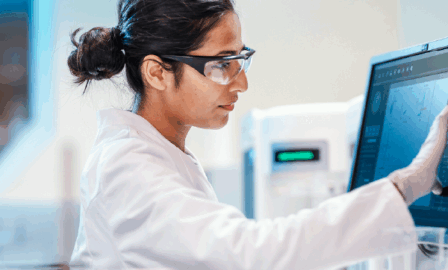Applications of 3D Printing in Healthcare
3D printing has been in the healthcare industry since the early 1990s. Today, it’s used to create prosthetics, casts, organs, and various forms of personalized medicine. Both the 3D-printed medical device market and 3D printed pharmaceutical market have valuations that are continuing to grow with forecasts of $3.2 billion by 2026 and $522 million by 2030, respectively. With over two million amputees and 100,000 on the transplant waiting list in the US alone, it’s important for healthcare providers to generate affordable and accessible solutions. Additionally, the era of personalized medicine has fueled growth in 3D printing as consumers seek medical devices and drugs tailored specifically to them.
At its most basic level, 3D printing is the process of depositing material through a computer guided nozzle. Various machines can create complex plastic, polymer, or organic structures by layering from the ground up. 3D printing has the potential to slash costs for consumers and impact supply chains for those who need treatment most. Below we outline a few of the latest developments in and applications of 3D printing in healthcare.
Applications of 3D Printing: Prosthetics and Casts
Prosthetic limbs are notoriously expensive. The cost of an average prosthetic can range from $1,800 to $8,000, which can help explain why only 20% of those in need globally have one. To compound the issue, children typically require new prosthetic limbs every two years and adults every five. Companies can use 3D printing software to rapidly scan a patient and print a model for patients for as little as $50. As a child grows, the easily customizable software design allows their personal model to be scaled and reprinted as needed.
One of the most recent advancements in this space is from LIMBER, a student-led prosthetics startup out of UC San Diego. The team has developed a 3D printer that can print a fully finished prosthetic in as little as 12 hours–a remarkable feat considering it can take upwards of a week for traditional prosthetics.
In contrast, the benefit of 3D printing less complex casts is not in the cost, as traditional casts cost comparable amounts. Instead, the advantage lies in the customizability. 3D-printed casts allow for extremely personalized fittings which is desirable in the era of personalized medicine. New advancements for 3D-printed casts, however, are far less prevalent beyond interchanging materials for minor wins like waterproofing. This is not to say that 3D-printed casts and prosthetics won’t become more readily available, but the initial excitement surrounding advancements like the Osteoid, a 3D-printed cast that implemented ultrasound to speed up healing, has rapidly died down since 2014.
Healthcare providers must consider that unless 3D printers are available in-house, personalized medical devices must be outsourced to external life science manufacturers. These external firms must also recognize that supply chain logistics for personalized medical devices are far more complicated and costly than those for mass produced products. These manufacturers must contend with individual traceability to ensure that medical devices reach the correct patients securely.
Additionally, assembly lines are no longer able to pump out similar products and must rather focus on unique and less efficient tailoring. Without a leading supply chain partner to manage these more complicated logistics, life science manufacturers may be discouraged to fully enter the industry. While startups like LIMBER possess their own equipment, this is certainly not the industry standard for long-standing healthcare providers and life science manufacturers. Consequently, these established firms must run cost benefit analyses for making the initial large investment into 3D printing machinery.
Organs, Biomaterial, and Pharmaceuticals
Of the developments covered thus far, researchers and engineers are furthest from fully developing 3D-printed tissue, organs, and other biomaterial. While it’s especially appealing to consider a future with readily available organs grown from our own cells, we may still be decades away. Nonetheless, the draw of custom-built organs with virtually no chance of being rejected by the body has development firing on all cylinders.
Current processes involve creating a small scaffolding from sugar or an algal byproduct before layering stem cells on top that grow as the structure dissolves. While 3D printers today lack the precision to recreate functioning organs, they can produce tissue and other less complex biomaterial. This can then be used to test drugs and other treatments on human cells more safely.
Life science manufacturers can be excited about 3D printing for biomaterial because of an existing $1.7 billion market valuation that is predicted to grow at a CAGR of nearly 10%. While many of the aforementioned supply chain challenges for medical devices still apply, especially with more stringent chain of identity regulations, this market potential for 3D-printed, personalized biomaterial may far outweigh the cost. In addition, life science companies can save time and money in clinical trial phases by conducting tests on printed biomaterial. For certain firms that dedicate tremendous resources to lengthy clinical trials, this alone may be worth the investment.
The only FDA approved 3D-printed pharmaceutical is currently Spritam, a tablet that treats epilepsy. The broad advantages of 3D-printed drugs include personalized dosages, pill sizes, treatment combinations, and release characteristics. Approved in 2015, Spritam allows large dosages of anti-epileptic medication to release within seconds of ingestion. It can be expected that this rather unsaturated pharmaceutical market will become more competitive throughout the decade with a forecasted market valuation of $522 million. But perhaps more than any other 3D-printed treatment in healthcare, pharmaceuticals will be regulated heavily by chain of identity regulations and the FDA to ensure that medications are received by the correct patients safely.
Moving Forward with 3D Printing in Healthcare
Challenges posed by 3D printing like scalability for tailored products, supply chain logistics with traceability and chain of identity, and a rather untested consumer base may still be well worth the cost. To fully capture the payoffs of emerging technologies like 3D printing in healthcare, it’s important for manufacturers to work with strategic partners and life sciences consulting experts who are able to efficiently and successfully implement them.
Subscribe to Clarkston's Insights
Contributions from Jake Park-Walters



